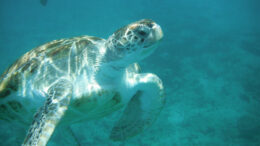 Another updated article from the “Extinction Countdown” archives. Originally published in 2016, but still relevant to today.
Another updated article from the “Extinction Countdown” archives. Originally published in 2016, but still relevant to today.
Is wildlife tourism safe for wildlife? It all depends on how it’s done. According to one study, green turtles (Chelonia mydas) featured in eco-tourism operations can experience a few interesting benefits as well as some potentially dangerous downsides.
The study, published in the Journal of Wildlife Diseases, was conducted in Barbados, where a thriving tourist industry features numerous opportunities for visitors to jump in the water and swim with wild sea turtles. A team of researchers from the West Indies, U.S. and United Kingdom wanted to see how those endangered turtles fared amidst this well-intentioned activity. The researchers selected 29 green turtles from four sites around Barbados and gave them each a full medical workup.
The results depended on where the turtles lived. As the researchers wrote in their paper, many of these attractions allow tourists to hand-feed the animals, an activity widely promoted in official Barbados tourism marketing.

This food — which “supplements” the turtles’ natural diet, according to the researchers — includes whole or chopped up fish, chicken, hot dogs, bread and “various other leftovers.”
The juvenile sea turtles who received this food enjoyed more than a tasty meal. They also grew bigger, faster. According to the paper, they had significantly larger carapaces and body weights about three times as heavy as the turtles that came from areas where their natural diets were not enhanced by human handouts. That rapid growth means they potentially have better chances of survival from predators.
But blood panels and other tests revealed something else. The turtles with supplemented diets also had much higher levels of triglycerides, blood urea nitrogen and cholesterol. In fact, just about everything the researchers tested for in the diet-supplemented turtles existed at higher levels. This, the researchers wrote, leaves the turtles at risk of health conditions including liver disease, gout and cardiovascular issues — you know, the same health problems humans face from our atrocious diets.
And that’s not all: Previous research cited in the paper already indicated that feeding green turtles in Barbados puts the animals at greater risk. The animals learn that humans are a friendly food source, which makes them more vulnerable to boat strikes and other injuries, or to being captured when they swim outside of protected waters.
That doesn’t mean, however, that the researchers thought the industry should be shut down. In fact, they wrote that such an action is unlikely because tourism is an important source of income in Barbados.
But they warned that existing codes of conduct may not be enough. The authors suggested that operators should provide turtles with more natural food on a limited basis, perhaps once a day. They also recommended establishing a health-monitoring program to ensure that sea turtles who receive supplemental food aren’t suffering as a result.
So should tourists swim with sea turtles, or participate in other wildlife encounters? The paper doesn’t make a recommendation either way, but as someone who’s been writing about wildlife issues for 20 years, I think the conclusions are clear:
-
- Select activities that don’t stress out or change the behavior of the animals you want to see.
- Keep your distance. If an animal approaches you, fine. But don’t approach them on your own, and don’t chase them down just to get the perfect camera shot.
- Pack a mask, and skip the trip if you’re sick. Many species are susceptible to human diseases.
- Choose operations that devote a portion of their revenue to conservation efforts, research and habitat preservation. (Wildlife rescue centers or sanctuaries are often, but not always, a good option.)
- Don’t support facilities that offer (or sell) opportunities to hold, touch, pet or pose with wild animals. These activities often support unethical breeding programs, or discard animals once they grow to big and feisty for photo ops.
- Expect to learn something. The best ecotourism operations include an educational element.
- Leave no trace. The last thing a wild animal needs is the plastic wrapper from your snack, or an introduced plant seed from the sole of your shoe.
- Opt for the low-carbon option. Climate change puts many species at risk, and burning fossil fuels to see them does more harm than good in the long run.
- Don’t share photos of people touching or holding wild animals. That encourages bad behavior.
- And don’t feed the animals.
In other words, if you want to snorkel with green turtles, go for it — just leave the hot dogs on the boat.
![]()



